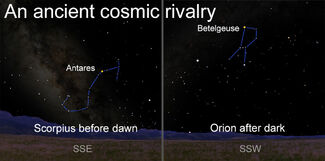A Rivalry of Cosmic Proportions
Last updated 3/22/2022 at 11:02am

No matter when you look, you'll never find Orion and Scorpius in the sky together. As Orion sets, Scorpius rises. And as Scorpius sets, Orion rises.
Gazing into the dark, starry heavens of a cool springtime evening is one of the most delightful and tranquil experiences one can have. Often the most dramatic event we might experience is to watch as a meteor rips across our sky.
One would never guess that this seemingly peaceful stellar canopy is home to one of the most bitter rivalries of ancient lore. The celestial combatants are represented by two of the largest and most familiar constellations in all the heavens: Orion, the hunter, and Scorpius, the scorpion.
Orion appears as a prominent hourglass of stars with three equally bright stars crossing its midsection. Ancient sky watchers imagined this stellar grouping as a great hunter, with two stars marking his shoulders, two marking his knees, and three more forming his belt. Fainter stars represent his outstretched shield and club, while a sword hangs from his belt in the form of a hazy patch of light known to astronomers as the Great Orion Nebula. His head is marked by a rather faint star named Meissa.
The great hunter now shines in the south-southwestern sky after dark, but stargazers will notice that his nemesis Scorpius is nowhere to be found.
To see it at this time of year you must rise before the sun and gaze toward the south-southeast. There, not far above the horizon, you'll easily spot the scorpion's body and long curving tail, its stinger and its claws. The bright reddish-orange star Antares forms the heart of the great arachnid. Amazingly, Scorpius is one of the few star groupings that actually resembles its namesake.
Scorpius has a long and fascinating history. It's one of the oldest constellations in the heavens, and historians believe it to have been first pictured by Euphratean astronomers seven millennia ago as one of the original six zodiacal signs. While ancient cultures of Persia, Turkey, India and possibly even the Mayans of Mexico saw this star grouping as a scorpion, others did not. In ancient China, for example, the same stellar figure was considered a major portion of the large and regal figure of the Azure Dragon or Dragon of the East. And in the South Pacific, Maori legend describes it as the magic fishhook that Maui used to raise the islands of New Zealand from the ocean.
No matter when you look, however, you'll never find Orion and Scorpius in the sky together. As Orion sets, Scorpius rises. And as Scorpius sets, Orion rises. Doesn't seem like these two cosmic rivals could possibly stir up much trouble. And that's exactly the point.
In ancient Greek and Roman mythology, Scorpius represents the scorpion whose sting caused the death of the great hunter. And, as the story goes, when the gods immortalized these two mythological figures in the heavens, they separated their constellations as widely as possible to prevent them from stirring up trouble in the heavens as they purportedly did on Earth.
Today, we in the Earth's Northern Hemisphere associate the constellation Orion with the winter sky, and Scorpius with the summer and, because of the wisdom of the great ancient stargazers, the tranquility of our nighttime sky will never be shattered.



